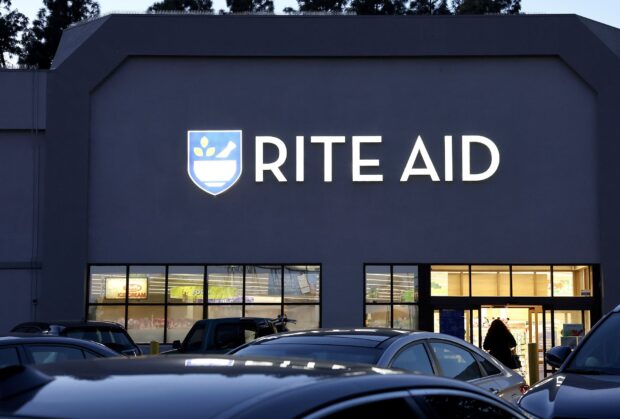Nancy Zailo is at the back of the line.
She’s behind Jeffrey Stein, the Rite Aid Corp. chief executive collecting $300,000 paychecks every month. She’s behind consultants at Alvarez & Marsal, who have billed the pharmacy chain $75 million and counting. She’s behind bondholders and behind $2,000-an-hour lawyers from Kirkland & Ellis. And she’s behind lenders like Bank of America Corp. and Wells Fargo & Co. that are collecting millions of dollars in interest from a credit line carrying the company through bankruptcy.
Only after they’ve all been paid—along with many, many others—could some of what’s left go to thousands like Zailo who allege the drug store chain ignored red flags as it fed their opioid addictions for years. “I lost everything,” she said.
Here’s what she’s expected to get: Nothing.
The plight of people like Zailo, it turns out, does little to bend the rigid structures of the US Bankruptcy Code. In fact, insolvency rules make it pretty easy for Rite Aid to nearly ignore its opioid claimants altogether. Rite Aid, which has denied wrongdoing, faced more than 1,600 opioid lawsuits when it filed for bankruptcy in October.
While rivals Walmart Inc., CVS Health Corp. and Walgreens Boots Alliance Inc. agreed to pay more than $13 billion combined to settle opioid lawsuits, Rite Aid never reached a similar accord before its bankruptcy filing put litigation on hold. The company told opioid plaintiff lawyers it didn’t have the funds, according to people with knowledge of the negotiations, who asked not to be named because the talks were private. And unlike drugmakers that have gone bankrupt, the retailer doesn’t expect it will wind up with any money to pay opioid victims.
“Bankruptcy is perceived as a strategic tool that provides enormous leverage in negotiations with injured people,” said Melissa Jacoby, a law professor at University of North Carolina Chapel Hill. “It’s a real problem that bankruptcy is being used this way, even when a company has other financial problems.”
Rite Aid’s restructuring talks have focused on how much it can afford to repay its secured creditors before either selling itself or reorganizing into a new company, immune from future opioid lawsuits. People like Zailo are simply lumped in with every other general unsecured creditor, meaning they’re among the last to get any compensation.
Bankruptcy is notoriously expensive, and large companies’ advisory fees often climb into the hundreds of millions. Just five months into its court proceedings, Rite Aid is facing at least $200 million in fees from lawyers, consultants and bankers, according to court records. In January it hired additional consultants to liquidate its assets. So high are the fees that some of the company’s creditors, themselves no strangers to expensive lawyers, have grown concerned about how rapidly they’ve been piling up, according to people with knowledge of the matter, who asked not to be named because the discussions were private.
Rite Aid and Wells Fargo declined to comment. Kirkland & Ellis, Alvarez & Marsal and Bank of America didn’t respond to requests for comment.
Prescriptions were a major part of Rite Aid’s business. Dispensing medication regularly accounted for around 70 percent of the company’s total drugstore sales over the years, regulatory filings show. Drugs were a buoy for the retailer as it fell into disrepair amid stiff competition and shifting shopping habits.
Pharmacists are required to conduct due diligence when filling prescriptions to make sure they are for a legitimate medical purpose. A whistleblower lawsuit filed by three Rite Aid pharmacists in 2019 alleged the company illegally filled “hundreds of thousands” of invalid prescriptions and billed the US government for ones that were covered by Medicare and Medicaid. The US Justice Department intervened in the case in March 2023 to file its own complaint in support of the allegations, saying Rite Aid’s practices “opened the floodgates” for millions of illegal opioid pills.
The company deleted pharmacists’ internal notes that raised concerns about certain prescribers, including ones as blunt as “cash only pill mill???” and “writing excessive dose[s] for oxycodone,” according to the DOJ. The company also had systems in place to ensure pharmacists were working as fast as possible, regardless of how suspicious a prescription might be, according to the whistleblower suit.
Rite Aid filed a motion to dismiss the case soon after the DOJ intervened, arguing that the government’s allegations “rest on nothing more than its disagreement, with the benefit of hindsight, with doctors’ prescribing decisions.” The company also added that its pharmacists used professional judgment in filling prescriptions, and that the firm helped to support them.
Rite Aid was Zailo’s go-to pharmacy after she shattered her wrist when she was thrown through the windshield of her car in 1994. The pharmacy was across from her doctor’s office in Denville, New Jersey, and it soon became a frequent stop for her. She said her prescriptions always came quick, even as her daily dose of OxyContin rose to 800 milligrams—enough to last a typical patient two weeks. She says she also got other drugs like Percocet, Vicodin and Xanax there.
The pharmacists would even fill Zailo’s prescriptions early if she was willing to pay in cash, she said. She says she saw multiple pharmacists over the years there, and none of them questioned her outsize dosage or early fills.
A graphic designer at the time of her accident, she eventually ended up homeless for a time before recovering from her addiction around eight years ago. She now relies on social security disability assistance because of a stroke she suffered during an episode of withdrawal and supplements her income by selling hand-crocheted garments.
After Rite Aid’s bankruptcy, Zailo volunteered to serve on the proceeding’s official tort committee, a group that represents people who say they were hurt by the company. Although she wasn’t among those who sued Rite Aid before its financial collapse over its alleged role in the opioid crisis, she has joined those who are now asserting a claim against the company for damages. It’s the last chance she has to try to get compensation.
“Fortunately, the opioids are gone,” she said over Zoom in late February. “Unfortunately, the pain’s still here.”
The company earlier agreed to pay at least $42 million to settle separate cases brought by New York’s Suffolk County, three other local governments and the state of West Virginia. But it never reached a global settlement.
That’s in part because Rite Aid has been struggling for years. A much bigger rival, Walgreens, tried to buy the company for about $17 billion in 2015, but the deal got hung up on antitrust concerns and Walgreens settled for buying close to half of Rite Aid’s stores instead. What was left of the chain started racking up annual losses in 2019, and three years later, then-CEO Heyward Donigan acknowledged that the traditional retail part of its business was “in a deteriorating state.”
Last year, Rite Aid filed for Chapter 11 bankruptcy, listing debts of $8.6 billion, close to $1 billion more than the value of its assets at the time. The company got a new $200 million loan in Chapter 11 and continued access to an existing credit line from a group of its secured lenders after it agreed to bump up more than $3 billion of their old debt in the repayment line.
Rite Aid is still trying to sell its retail business. But its back-up plan involves shedding a lot of debt, shutting down more than 600 stores and giving the remaining pharmacy business a fresh start. Mediated talks with the committee of mass tort claimants are ongoing, so their outcome could change if a deal is struck. But Rite Aid said in court papers as recently as Feb. 20 it doesn’t expect for there to be any money left for opioid plaintiffs after paying higher-ranking debts.
Companies often dole out millions to advisers in the months leading up to a bankruptcy filing, and Rite Aid was no exception. The company paid around $90 million to advisers, investment bankers and lawyers in the months before the bankruptcy, according to court papers. Consultants at Alvarez & Marsal and lawyers at Kirkland & Ellis charged the company $34 million and $16 million, respectively, during the bankruptcy case through the end of December. Their fees from January and February have not yet been disclosed.
Then there are the executive bonuses. Rite Aid paid more than $18 million in bonuses to executives before filing for bankruptcy. Stein, who was appointed as the company’s chief executive officer the day it went bankrupt, is due to get a payout of as much as $20 million when the company emerges from the court process, according to a regulatory filing. That’s not far from what Walmart’s chief executive officer received in salary last year.
Meanwhile, Zailo is waiting alongside thousands of other opioid victims to definitively find out if the company will compensate her at all. The bankruptcy is the last real chance for them to argue that Rite Aid should have to pay opioid victims. Once a federal judge signs off on the company’s restructuring plan, it will be largely cleansed of previous wrongdoing and shielded from future lawsuits.
The company had a responsibility to “monitor what doctors were prescribing and patients were taking and how often,” Zailo said. “There should have been a better system in place. I knew what was going on wasn’t right.”
Top photo: Photographer: Mario Tama/Getty Images North America.



















 Why the Middle Market Matters and How Insurers Can Capture It
Why the Middle Market Matters and How Insurers Can Capture It  Berkshire Hathaway Enters Post-Buffett Era as Share Prices Fall
Berkshire Hathaway Enters Post-Buffett Era as Share Prices Fall  Market Softening Accelerates During 1/1/2026 Re Renewals
Market Softening Accelerates During 1/1/2026 Re Renewals  Why ‘Good Enough’ Is Killing Insurance: The Hidden Cost of Satisficing
Why ‘Good Enough’ Is Killing Insurance: The Hidden Cost of Satisficing 










